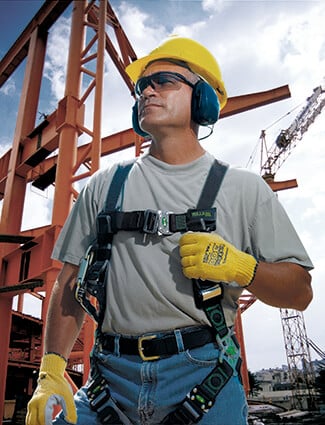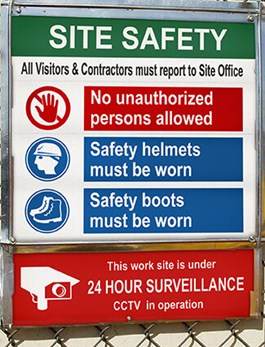OSHA Construction Safety

What is OSHA Construction Safety?
When it comes to safety, the construction industry has a higher fatality rate than the national average. In an effort to reduce worker injuries and fatalities, OSHA has created a comprehensive set of safety standards, as well as a construction safety digest, safety training guides, and more.
OSHA Construction Safety Background
Safety should be first and foremost on every employer's and employee's mind. And given that 20.5% of worker fatalities in 2014 were in construction, it's imperative that employers make sure the workplace is safe. To this end, OSHA requires that employers maintain a safe work environment and follow all related OSHA safety and health standards. Most of the applicable standards can be found in 29 CFR 1926, Safety and Health Regulations for Construction; when there is a workplace hazard not covered there, it may be covered by the General Industry Standard 29 CFR 1910.
In the rare case that a hazard is not specifically covered in either part 1926 or 1910, it may be covered by Section 5 of the Occupational Safety and Health Act of 1970, otherwise referred to as the General Duty Clause. The General Duty Clause states that each employer must provide a place of employment "free from recognized hazards that are causing or are likely to cause death or serious physical harm." In other words, if an employer is aware of a hazard and does not take appropriate action to mitigate the hazard, OSHA may issue a citation under the General Duty Clause.
OSHA Construction Safety Education
Proper training and education is the first line of protection when it comes to worker safety. OSHA requires all training to be done in a language and vocabulary that workers understand. This can mean providing training in several languages.
In general, OSHA requires that training includes the following:
- How to recognize hazards that are or may be present in their workplace
- How to avoid hazards present in their workplace
- When Personal Protective Equipment (PPE) is needed and how to properly wear it
Training should cover all potential hazards, safe work practices, and emergency situations. Special attention should also be given to the "Fatal Four," which caused over 50% of all construction worker fatalities in 2014, according to OSHA.
The "Fatal Four" includes falls, electrical hazards, falling objects, and crush hazards (being caught between a moving object and a fixed object). To help improve workplace safety and reduce falls, Duralabel created an OSHA Fall Protection Guidelines and Standards Infographic that can help you better understand OSHA's fall protection standards.
By identifying specific dangers at a given construction site, employers can develop a well-thought, effective training program that provides workers with the knowledge they need to stay safe. Remind workers about safety practices and communicate hazards throughout the worksite with safety signs and labels that can be seen and understood.
OSHA Construction Safety Methods
Improving construction safety is a complex task that requires a holistic safety approach. This requires employers to use the following methods:
- Engineering controls
- Safe work practices
- Personal Protective Equipment (PPE) assessment and training
- Daily inspections and preventive maintenance
- Employee injury and illness programs
Using each of these methods will ensure that workers remain safe by eliminating and reducing workplace hazards.

Engineering Controls: Eliminating or reducing hazards through engineering controls is the most effective means of preventing workplace injuries and deaths. Engineering controls focus on the following:
- Designing equipment, processes, and buildings in a manner that will completely remove hazards. When it is not possible to eliminate a given hazard, a lesser hazard may replace it. This is called substitution.
- When the hazard cannot be eliminated or substituted, other methods like guarding, barriers, or ventilation systems can be used to limit employee exposure to the hazard.
Safe Work Practices: Safe work practices include the rules and work procedures used at a construction site. This includes following Lockout/Tagout (LO/TO), requiring workers to use the correct PPE and providing safety oversight for dangerous work, like working in confined spaces.
PPE Assessment and Training: Every worksite has hazards that must be further reduced by using PPE. Hard hats can protect workers from falling and impact hazards while respiratory gear can reduce exposure to silica dust, lead, and other harmful chemicals.
Before work can begin, hazards must be evaluated to determine which PPE is needed. Workers must then be trained, so they know when to wear PPE as well as how it must be worn. All PPE must be regularly inspected and properly maintained.
Preventive Maintenance and Daily Inspections: Good preventive maintenance plays a major role in ensuring that equipment does not create hazards when used. Meanwhile, daily walk-around inspections provide a useful means for employers to spot problems before they become hazardous. For example, an inspector might find that a trench's shoring has been damaged and close the trench to further work until it is fixed.
Injury and Illness Prevention Programs: Employers can further reduce workplace injuries with an injury and illness prevention program. Workers are trained to recognize and treat health problems like heat stroke, concussions, and more. Programs include providing first aid training and stocking worksites with basic medical supplies needed to treat many common workplace injuries. They should also include a means to quickly contact emergency services when needed.
 Construction Safety Visual Communication
Construction Safety Visual Communication
An important part of construction safety is effective communication. One way employers can improve safety is by using safety signs and labels to communicate hazards and remind workers to wear PPE.
DuraLabel printers and supplies provide a robust safety communication solution for construction sites. Print custom labels and signs to ensure that your safety messages are seen and understood when they are needed the most. With more than 50 specialty supplies, you'll have the tools you need to create a safer worksite.
Support onsite safety training with large, easily understood posters, using Echo large-format printer and enlarger by Duralabel. Quickly enlarge important safety documents for meetings or create custom safety diagrams for training.
You can ensure that your work sites are OSHA compliant by downloading our free Construction Safety Guide below.
Related Resources

Study: Training Lacks for Immigrant Workers
A recent study shows that immigrant workers at smaller construction firms are less likely to have safety ...
Read
OSHA and Ironworkers Partner for Safety Outreach
OSHA and Ironworkers are partnering up to help boost safety programs and prevent the most common injuries, ...
Read
OSHA Scaffolding Standards: Essential Fall Protection Resources
In November 2013, a Massachusetts roofer fell to his death while working on a condominium. An OSHA ...
Read.png)





